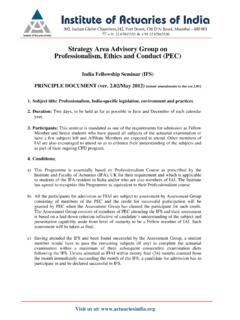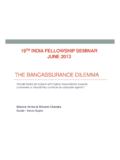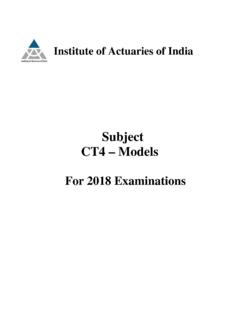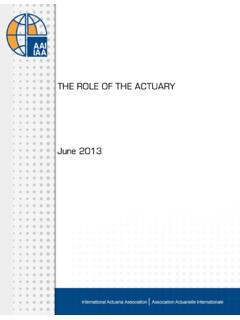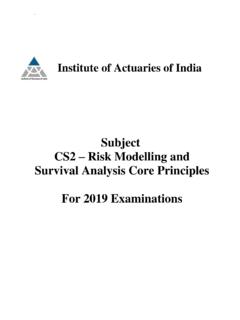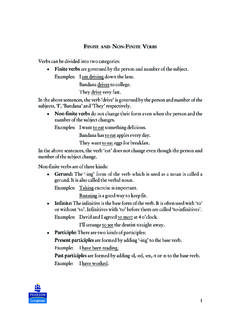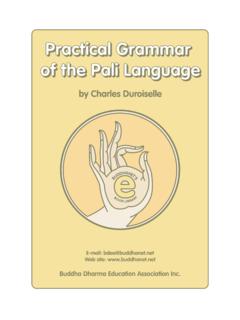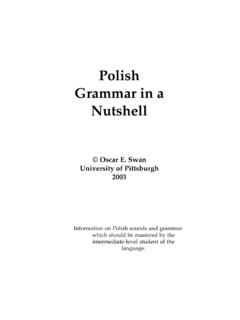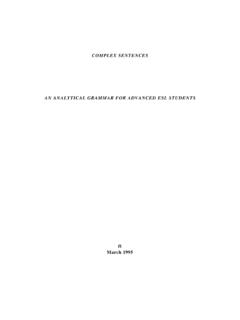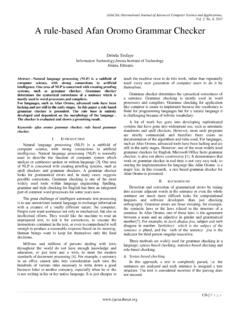Transcription of Subject CM2 Financial Engineering and Loss Reserving Core ...
1 Institute of Actuaries of India Subject CM2 Financial Engineering and Loss Reserving Core Principles For 2019 ExaminationsCM2 Financial Engineering and Loss Reserving Core Principles Page 1 of 9 Aim The aim of the Financial Engineering and Loss Reserving Subject is to provide a grounding in the principles of modelling as applied to actuarial work focusing particularly on stochastic asset liability models and the valuation of Financial derivatives. These skills are also required to communicate with other Financial professionals and to critically evaluate modern Financial theories. Competences On successful completion of this Subject , a student will be able to: 1 describe, interpret and discuss the theories on the behaviour of Financial markets. 2 discuss the advantages and disadvantages of different measures of investment risk. 3 describe, construct, interpret and discuss the models underlying asset valuations.
2 4 describe, construct, interpret and discuss the models underlying liability valuations. 5 describe, construct, interpret and discuss the models underlying option pricing. Links to other subjects Concepts introduced in CS1 Actuarial Statistics 1, CS2 Risk Modelling and Survival Analysis, CM1 Actuarial Mathematics 1 and CB2 Business Economics are used in this Subject . Topics in this Subject are further built upon in CP1 Actuarial Practice, CP2 Modelling Practice, SP5 Investment and Finance Principles, SP6 Financial Derivatives Principles and SP9 Enterprise Risk Management Principles. CM2 Financial Engineering and Loss Reserving Core Principles Page 2 of 9 Syllabus topics 1 Theories of Financial market behaviour (15%) 2 Measures of investment risk (15%) 3 Stochastic investment returnmodels (10%) 4 Asset valuations (20%) 5 Liability valuations (20%) 6 Option theory (20%) The weightings are indicative of the approximate balance of the assessment of this Subject between the main syllabus topics, averaged over a number of examination sessions.
3 The weightings also have a correspondence with the amount of learning material underlying each syllabus topic. However, this will also reflect aspects such as: the relative complexity of each topic, and hence the amount of explanation and supportrequired for it. the need to provide thorough foundation understanding on which to build the otherobjectives. the extent of prior knowledge which is expected. the degree to which each topic area is more knowledge or application levels The use of a specific command verb within a syllabus objective does not indicate that this is the only form of question which can be asked on the topic covered by that objective. The Examiners may ask a question on any syllabus topic using any of the agreed command verbs, as are defined in the document Command verbs used in the Associate and Fellowship written examinations . Questions may be set at any skill level: Knowledge (demonstration of a detailed knowledge and understanding of the topic), Application (demonstration of an ability to apply the principles underlying the topic within a given context) and Higher Order (demonstration of an ability to perform deeper analysis and assessment of situations, including forming judgements, taking into account different points of view, comparing and contrasting situations, suggesting possible solutions and actions, and making recommendations).
4 In the CM subjects, the approximate split of assessment across the three skill types is 20% Knowledge, 65% Application and 15% Higher Order skills. CM2 Financial Engineering and Loss Reserving Core Principles Page 3 of 9 Detailed syllabus objectives 1 Theories of Financial market behaviour (15%) Rational expectations theory Discuss the three forms of the Efficient Markets Hypothesis and their consequences for investment management. Describe briefly the evidence for or against each form of the Efficient Markets Hypothesis. Rational choice theory Explain the meaning of the term utility function . Explain the axioms underlying utility theory and the expected utility theorem. Explain how the following economic characteristics of investors can be expressed mathematically in a utility function: non-satiation risk aversion, risk neutrality and risk seeking declining or increasing absolute and relative risk Discuss the economic properties of commonly used utility functions.
5 Discuss how a utility function may depend on current wealth and discuss state dependent utility functions. Perform calculations using commonly used utility functions to compare investment opportunities. State conditions for absolute dominance and for first and second-order dominance. Analyse simple insurance problems in terms of utility theory. Behavioural economics Describe the main features of Kahneman and Tversky s prospect theory critique of expected utility theory. CM2 Financial Engineering and Loss Reserving Core Principles Page 4 of Explain what is meant by framing , heuristics and bias in the context of Financial markets and describe the following features of behaviour in such markets: the herd instinct anchoring and adjustment self-serving bias loss aversion confirmation bias availability bias familiarity Describe the Bernartzi and Thaler solution to the equity premium puzzle.
6 2 Measures of investment risk (15%) Properties of risk measures Define the following measures of investment risk: variance of return downside semi-variance of return shortfall probabilities Value at Risk (VaR) / Tail Describe how the risk measures listed in above are related to the form of an investor s utility function. Perform calculations using the risk measures listed in above to compare investment opportunities. Explain how the distribution of returns and the thickness of tails will influence the assessment of risk. Risk and insurance companies Describe how insurance companies help to reduce or remove risk. Explain what is meant by the terms moral hazard and adverse selection . 3 Stochastic interest rate of return models (10%) Show an understanding of simple stochastic models for investment returns. Describe the concept of a stochastic investment return model and the fundamental distinction between this and a deterministic model.
7 CM2 Financial Engineering and Loss Reserving Core Principles Page 5 of 9 Derive algebraically, for the model in which the annual rates of return are independently and identically distributed and for other simple models, expressions for the mean value and the variance of the accumulated amount of a single premium. Derive algebraically, for the model in which the annual rates of return are independently and identically distributed, recursive relationships which permit the evaluation of the mean value and the variance of the accumulated amount of an annual premium. Derive analytically, for the model in which each year the random variable (1 + r) has an independent log-normal distribution, the distribution functions for the accumulated amount of a single premium and for the present value of a sum due at a given specified future time. Apply the above results to the calculation of the probability that a simple sequence of payments will accumulate to a given amount at a specific future time.
8 4 Asset valuations (20%) Mean-variance portfolio theory Describe and discuss the assumptions of mean-variance portfolio theory. Discuss the conditions under which application of mean-variance portfolio theory leads to the selection of an optimum portfolio. Calculate the expected return and risk of a portfolio of many risky assets, given the expected return, variance and covariance of returns of the individual assets, using mean-variance portfolio theory. Explain the benefits of diversification using mean-variance portfolio theory. Asset pricing models Describe the assumptions, principal results and uses of the Sharpe-Lintner- Mossin Capital Asset Pricing Model (CAPM). Discuss the limitations of the basic CAPM and some of the attempts that have been made to develop the theory to overcome these limitations. Perform calculations using the CAPM.
9 CM2 Financial Engineering and Loss Reserving Core Principles Page 6 of Discuss the main issues involved in estimating parameters for asset pricing models. Single and multifactor models for investment returns Describe the three types of multifactor models of asset returns: macroeconomic models fundamental factor models statistical factor Discuss the single index model of asset returns. Discuss the concepts of diversifiable and non-diversifiable risk. Discuss the construction of the different types of multifactor models. Perform calculations using both single and multi-factor models. Stochastic models for security prices Discuss the continuous time log-normal model of security prices and the empirical evidence for or against the model. Explain the definition and basic properties of standard Brownian motion or Wiener process. Demonstrate a basic understanding of stochastic differential equations, the Ito integral, diffusion and mean-reverting processes.
10 State Ito s Lemma and be able to apply it to simple problems. Write down the stochastic differential equation for geometric Brownian motion and show how to find its solution. Write down the stochastic differential equation for the Ornstein-Uhlenbeck process and show how to find its solution. Models of the term structures of interest rates Explain the principal concepts and terms underlying the theory of a term structure of interest rates. Describe the desirable characteristics of models for the term-structure of interest rates. Apply the term structure of interest rates to modelling various cash flows, including calculating the sensitivity of the value to changes in the term structure. CM2 Financial Engineering and Loss Reserving Core Principles Page 7 of 9 Describe, as a computational tool, the risk-neutral approach to the pricing of zero-coupon bonds and interest-rate derivatives for a general one-factor diffusion model for the risk-free rate of interest.

